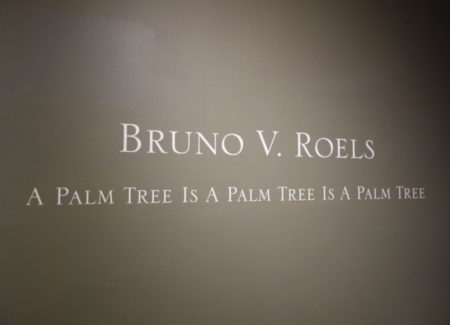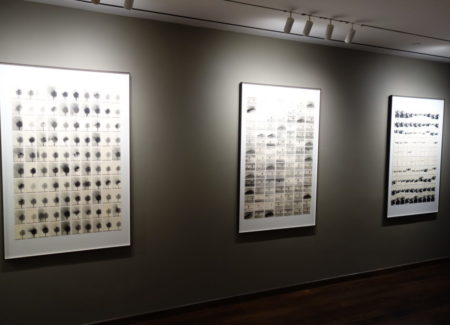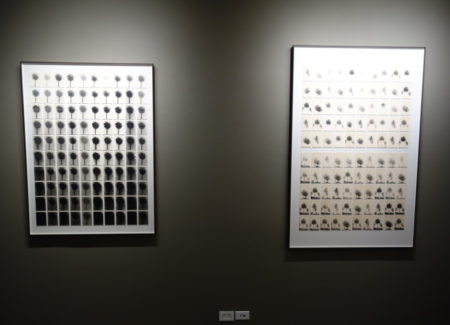JTF (just the facts): A total of 11 photographic works, mounted and framed in dark brown, and hung against green walls in the second gallery space. The following works have been included in the show:
- 1 overprinted gelatin silver print with ink, 2017, 20×17 inches
- 1 gelatin silver print with graphite, 2017, 16×12 inches
- 1 photogram diptych consisting of 2 prints on gelatin silver paper, 2018, 16×12 inches
- 1 composition of 72 gelatin silver prints, 2018, 72×45 inches
- 5 compositions of 100 gelatin silver prints (each), 2018, 61×39, 50×37 inches
- 2 compositions of 105 gelatin silver prints (each), 2018, 61×39, 67×43 inches
(Installation and detail shots below.)
Comments/Context: One of the ideas that is slowly being lost as we have moved into the always perfect world of point and click digital printing is the thought that each photographic print can be, and often deliberately is, a unique object. While new technologies have reduced or even effectively eliminated the print to print variation in the process of making multiple copies, it wasn’t so long ago that subtle changes in the darkroom, from tweaked exposure times and hand crafted dodging and burning to more aggressive cropping, enlargement, and negative rework, made a single image a flexible platform for a wide range of potential artistic outcomes.
But the Belgian photographer Bruno V. Roels hasn’t lost sight of this aesthetic opportunity. This show gathers together a selection of recent works that use images of palm trees (largely taken in southern Europe) as the starting point for elaborate exercises in repetition and iteration. While the palm tree might not seem like a particularly inspired choice of subject (although Ed Ruscha did have fun with a series of them in the early 1970s), there is enough variation in form, outline, and landscape placement in these source pictures to give Roels plenty of room to run. Single silhouetted specimens, pairs of trunks and canopies, clusters of trees set against the hazy desert horizon, and even a close up photogram of jagged leaves set the stage for extended improvisational riffs that take final shape as grids, arrays, and all-over patterns.
Over exposure and under exposure, paired with solarization effects, give Roels the ability to create tonal spectrums that run from washed out whiteness to murky dark. In one work, a single bushy lollipop shaped palm becomes progressively obscured until it reaches almost complete black, while in another of using similar form, the palm oscillates from one impermanent state to another, with double exposures catching the transitions. This effect is employed again with a paired set of angled trunks, where ethereal light and dark move back and forth in shifting shades of subtlety, each individual frame its own reality and the aggregate set powerfully undermining the idea that there is one “right” picture or one perfect representation of any one moment.
Roels also selectively employs cropping and blocking techniques, sequentially removing (or overexposing/washing to indeterminate white) portions of an image to change its composition. One work pairs two sets of prints, the first a group of bushy palms with a dark lower horizon, and the second a parallel group of versions of that same scene where the lower half has been removed or blotted out, turning the disembodied canopies of the palms into forms that recall fireworks in the sky. Other works that use this same technique take a palm scene and iteratively wash away parts of the image until only tiny snippets of palms in the sky remain, the left to right arrangement turning the array of prints into a slow exercise in erasure. A third work turns the removal into a vertical swipe, starting with a dark scene, erasing it until it is nearly entirely empty, and then progressively adding it back, like the ebb and flow of a wave.
So instead of the typology being employed as a conceptual structure used to compare a group of like objects or scenes, Roels re-envisions it as study of versions of the same image, effectively replacing content with process. What we are engaged with isn’t the palm tree itself or even Roels’ original source photograph, but the interactive and improvisational rework of that first impression into a burgeoning set of discrete alternate versions and exaggerated outcomes. In this way, printing becomes a way to transform one into many, the results which then become the raw material for further layers of patterned recreation. Seeing these works, there is a feeling that the recursive process can become endless, a single image of humble palm tree offering a constantly changing universe of engaging possibilities.
Collector’s POV: The works in this show range in price from $2800 to $20000 (with the grids of prints starting at $14000), with several works already sold. Roels’ work has little secondary market history at this point, so gallery retail likely remains the best option for those collectors interested in following up.














